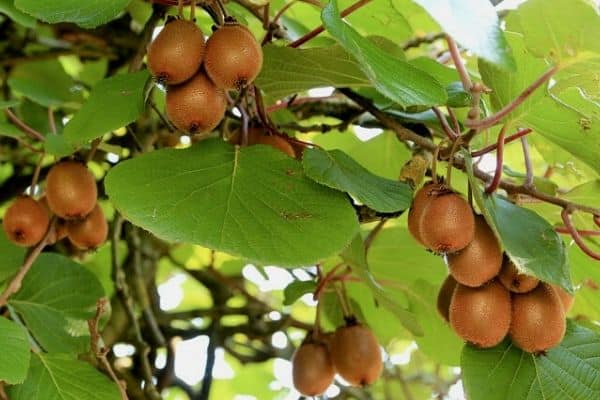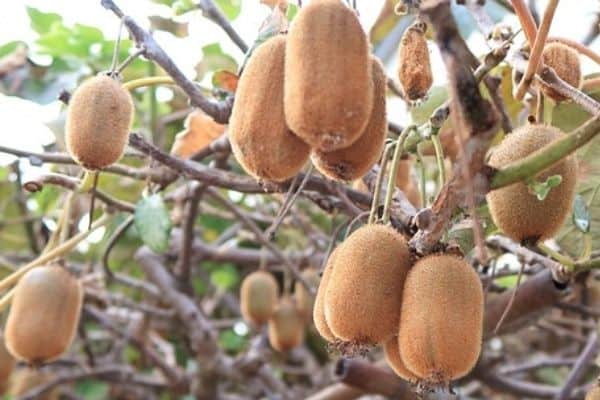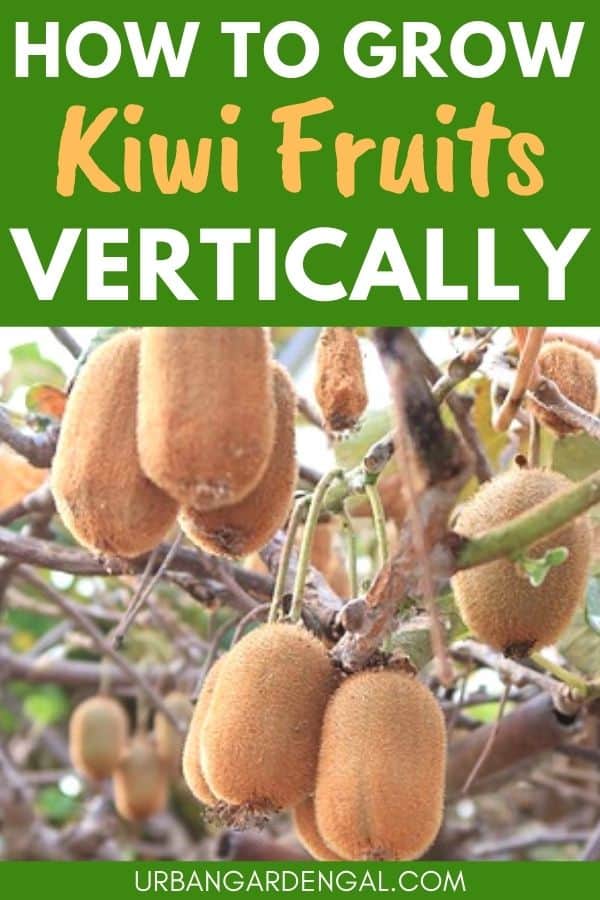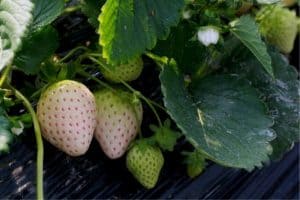Growing kiwis vertically is a great way to save space in your garden and it’s very satisfying to grow your own kiwi fruits.
Kiwi vines can be easily trained to grow up a trellis or vertical structure and they’re a nice addition to a vertical garden.
In this post I’ll share my best tips for growing kiwis vertically.
This article contains affiliate links. Please read the disclosure for more info.

Kiwis (Actinidia deliciosa) are small oval shaped fruits with fuzzy brown skin and green flesh on the inside.
Kiwi vines are perennials and they grow best in warm climates with short winters.
Advantages of growing kiwis vertically
Growing kiwis vertically takes up less space and helps to reduce pests and fungal diseases.
Growing kiwis up off the ground reduces the likelihood of the plants being eaten by slugs, snails and other pests.
It’s easier to harvest kiwis when they’re grown vertically and the vines are great for providing shade during summer.

How do you grow a kiwi vine vertically?
Firstly, make sure you buy male and female plants to ensure that you’ll get fruit.
Kiwis can be planted in spring when the risk of frost has passed.
Choose a sunny spot that receives at least six hours of sunlight each day and dig some compost or aged manure into the soil before planting.
Plant the kiwi vines at least 10 feet (3 metres) apart, close to the base of the trellis or vertical support.
There are lots of ways to make a trellis for your vines to grow up but how you do it depends on how much space you have available and how many plants you have.
You can make an inexpensive trellis by tying a few large diameter bamboo canes together with rope or wire.
Arbors, arches, pergolas and wire fences are also good for growing kiwi fruits vertically and they help to beautify your garden as well.
Train the vines to grow upwards by tying them loosely with soft twine or wire.
Kiwi vines will need regular watering until they become established, especially during hot weather.
It usually takes at least three years for new kiwi plants to start producing fruit, so you’ll have to be patient.
It’s a good idea to cover the vines with a bird proof net to protect the fruit as it’s ripening.
Kiwi vines lose their leaves in winter and they’re frost hardy in their dormant state, but the flowers and young tips will need protection from frosts in early spring.
Kiwi vines will keep producing fruit for many years but it’s a good idea to take cuttings from your plants after 3 to 4 years and use them to replace your old plants.

Harvesting kiwis
Kiwi fruits are ready to harvest in fall.
The fruits can be harvested when they’re still slightly hard and they will ripen at room temperature.
Don’t be tempted to harvest them too early though because the flavor won’t be developed enough.
Cut the fruits off the vine with garden shears, leaving a small piece of the stem attached.
Kiwi fruits can bruise easily, so handle them gently after harvesting.
How to store kiwi fruits
Ripe kiwi fruits will last for a few days at room temperature or up to a week in the refrigerator.
You can also slice kiwis and freeze them for up to six months.

How to eat kiwi fruit
Kiwis are delicious eaten straight off the vine and they’re also suitable for cooking.
You can cut them in half and scoop out the flesh or peel them with a knife and slice them.
Kiwis can be added to fruit salads, cocktails and smoothies or use them to make sorbet or kiwi cheesecake.
RELATED ARTICLES
- Kiwi Fruit Growth Stages
- 10 Climbing Fruit Plants
- How To Grow Gourds Vertically
- How To Grow Strawberries Vertically
So there are my tips for growing kiwi fruits vertically.
Trellising kiwi vines means that it’s possible to grow an abundant crop of kiwis even if you have limited garden space.
Have you tried growing kiwis vertically on a trellis? I’d love to hear about it in the comments below.
Are you on Pinterest? I have boards dedicated to Climbing Plants and Gardening Tips that you may find interesting. You can also find me on Facebook.





